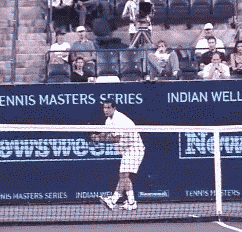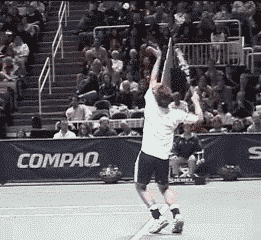|
TennisOne Lessons Teaching in Reverse - the Service Action by Jim McLennan The serve is perhaps the most complicated stroke in tennis. Many body parts combine within a certain rhythm to create racquet head speed. The timing of the swing positions the highest racquet head speed at impact, as opposed to swings where the racquet momentum peaks either well before or well after impact (which unfortunately is too often the case). Teachers do not uniformly agree on the mechanics of this delivery. And to compound the problem, the racquet is going so darn fast that it is nearly impossible to discern its movements when observing with the naked eye.
There can be a general distinction made between the service motion and the service action. The motion is the "macro" view of the delivery - Is the server on balance? Is there a rhythm that builds racquet speed to a crescendo at impact? The motion includes the stance, use of legs, hips, and torso, and the way in which the arm swings at the ball. The service action, on the other hand, concerns how the forearm, wrist, and hand snap the racquet into the ball. The service action is the "micro" view, and it concerns how the hit sounds, and the relationship between effort and output. Meaning. Does the server work hard for little result? Or conversely, does the server get a big hit without the appearance of undue effort? Certainly Federer or Sampras fall within the category of a good service hit without the appearance of work, and any struggling server (on tour or at your local courts) falls into the category of too much work and too little output - I am avoiding naming names here to diminish the emails in defense of those favorite players of the readership who may or may not serve well. Presuming the motion is balanced and rhythmic, the key to the serve may actually be in the mechanics and sequencing of the action. In fact, at a conference in London a few years ago, I was impressed by Miguel Crespo when he said, "Do not teach anything about the serve, this includes the grip or how to hit the ball, until the student is on balance and in rhythm." Succinct, and to the point. Readers, as you experiment with the following tips on the service action, do not overlook the foundation of the service motion - namely are you on balance and feeling rhythm?
Don Kerr, my last coach and great friend, developed his material on teaching the serve, from his experience as a world class badminton coach. As Don always reminded me, the badminton clear shot is an overhead designed to move the opponent back as far as possible from the net. This clear shot is struck with an "up and out" action, if there is any downward snap the shuttlecock does not fly as far. And, importantly, this "up and out action" is identical to the action used by the best servers. So where is the teaching in reverse? If there are numerous distinct and sequenced actions in the serve, then isolating those actions and practicing them in reverse order may actually enhance one's feel and awareness. Certainly, John White of the gyroscopic material in Batting Basics used this approach, and provided my son and I many a pleasurable hour in the back yard practicing a whipping batting stroke. So what are the mechanics of the service action and how would they be presented in reverse order. (Apologies to those of you who believe in the wrist snap, for it will not be included within the following. I once came upon an article by Vic Braden and Gideon Ariel stating that one could serve at full power were the wrist in a cast and therefore immobile. I read and reread this article and never truly got the concept until Don Kerr got me into the following drills. Skeptics, read on.)
Unscrew the Light Bulb Starting with the arm up, and thumb pointing backward, turn your arm and forearm, as though unscrewing a light bulb in the ceiling. Careful not to pull the light bulb from the ceiling, or break it off at its base (though we are only pretending here). Now with a racquet positioned roughly in line with the backward pointing thumb, introduce a ball into this turning motion and see if you can propel the ball forward. The last part of the service action, as the racquet strikes the ball, is this "endorotation." Pancho Gonzalez, Pete Sampras, Roger Federer, Andy Roddick - at the top of the swing they all turn the forearm into the hit. And this move occurs not during the overall swinging of the arm, but rather quickly and at the absolute top of the swing. Throw a dart in the ceiling. As the racquet is pulled up toward the top of the swing, how is it positioned? Imagine throwing a dart not into a wall but rather up and into the ceiling. This moves the elbow up and into a flexed position, where the thumb now points down, and the lower the better. With the racquet positioned so the butt cap faces the sky, and the racquet head dangling low (dangle to imply something loose), feel an upward pulling motion as though the racquet were a dart.
On this note, revisit the 1984 Masters tournament in Stockholm, John McEnroe vs. Anders Jarryd. Jarryd holds serve and on the changeover McEnroe repeatedly bashes his racquet on the court surface then walks to his chair. Unaware he had broken the racquet in the throat area, he walks to the service line for his first serve, swings quickly and the racquet head flies off from the racquet, this is true. How far and in which direction? The racquet head flew some 30 feet into the air, and landed directly on Mac's baseline - he was swinging up - the dislodged racquet head told the story. So experiment with the light bulb and the dart. And perform these experiments in the service box, so as not to confuse judgment of a successful serve, with the feel of these two elements. In time, this up and out snap may actually work its way into your service action. Your comments are welcome. Let us know what you think about Jim McLennan's article by emailing us here at TennisOne.
|
|||||||||||




